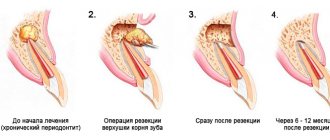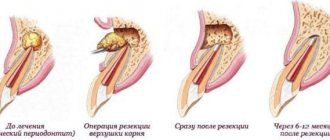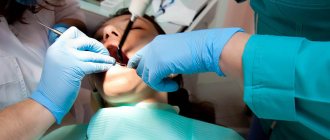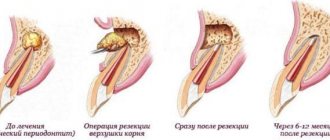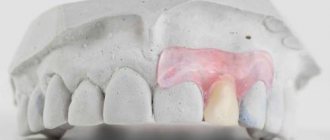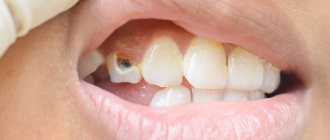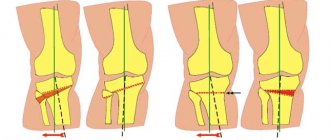From this article you will learn:
- in what cases is tooth resection performed?
- photo and video of the operation,
- tooth root resection: patient reviews, price 2021.
The article was written by a dental surgeon with more than 19 years of experience.
Root apex resection is a surgical method for treating granulomas and cysts that form at the root apex due to chronic inflammation (caused by infection in the root canals of the tooth). Granulomas and cysts are subtypes of a disease called chronic periodontitis.
They differ from each other only in size... If the inflammation at the root apex is more than 1 cm in diameter, the formation is called a radicular cyst, and if it is less than 1 cm, it is called a granuloma or cystogranuloma. Visually, they look like a “bag of pus” attached to the top of the tooth root.
Thus, the main indications for resection are the presence of an inflammatory focus at the apex of the tooth root, which is difficult to cure using conservative treatment methods for chronic periodontitis. The latter consists of temporarily filling the root canals with preparations based on calcium hydroxide (for a period of 2-3 months).
How is tooth root resection performed?
The meaning of the resection operation is to cut off the apex of the tooth root with a drill along with the “purulent sac”. And many patients are therefore immediately interested in the question of how long the tooth will last after resection. It must be said that the operation does not affect the service life of the tooth in any way, because The size of the root part to be removed is very small.
Tooth root resection is a fairly simple operation and usually lasts from 20 to 40 minutes. The front teeth are operated on faster, which is due to the convenience of visual control of the operation, but the lateral teeth (6-7 molars) require more effort and time from the doctor. In the animation below you can see all the main stages of the operation.
Tooth resection: animation
Preparing for surgery –
Tooth resection can be carried out only if there is no active purulent inflammation in the area of the root apex. If there is swelling of the gums or pain when pressing on a tooth, you must first remove the active inflammatory process.
The essence of preparation for surgery is high-quality filling of the root canal (Fig. 4). If resection is planned as the final stage of therapeutic treatment of chronic periodontitis, then the root canal is filled no more than 1 day before surgery (24stoma.ru). It is important that the canal is very tightly filled with a filling substance (for example, gutta-percha), because if the obstruction of the canal is not dense, the granuloma/cyst will then appear again.
If the operation is planned on a tooth where the root canals have already been filled, then the strategy may be different. For example, if the canal of this tooth is well sealed along its entire length (except at the very top of the root), it is not necessary to unseal such a canal, because the top will still be cut down. In all other cases, root canal refilling will be required.
Operation technique –
The operation is performed under local anesthesia and is absolutely painless. Moderate pain occurs only after the operation is completed, which will require taking painkillers. Below you can see the progress of the operation in detail on schematic images and videos, but first we will draw your attention to the main points during the operation.
Main stages of the operation –
Creating access to the root apex - the gum is dissected and moved away from the bone in the projection of the root apex of the causative tooth. After this, a “window” is drilled into the bone with a drill, through which the apex of the root is cut off and the granuloma or cyst is scraped out (Fig. 4b).- Root resection and cyst removal - through a hole created in the bone, the surgeon cuts off the tip of the root and scrapes out a chronic source of inflammation (this can be a granuloma or a cyst). The latter differ from each other only in size. The cyst shell must be removed completely, because if you leave even a small fragment of it, the cyst will form again.
- Suturing the wound - after antiseptic treatment of the wound, the edges of the gum mucosa are put in place and the wound is sutured. In good clinics, immediately after the operation the patient will be given ice to hold, pressing it to the cheek in the projection of the operation (this will reduce the amount of swelling). The stitches are removed after 8-10 days.
Operation diagram (Fig. 5-10) –
If the cyst was large, then bone healing can be stimulated with special osteoplastic materials based on synthetic hydroxyapatite - the preparations “Kolapol” or “Kollapan”. In some cases, retrograde root canal filling may also be used during resection surgery (see below).
Possible complications after cyst removal
Removing a cyst is a necessary procedure; the longer the treatment of a cyst is delayed, the more likely complications are to develop. There is no need to be afraid of removing a cyst; according to statistics, the percentage of possible adverse consequences is immeasurably less than complications from an unoperated cyst (abscess, phlegmon, sepsis).
After cystectomy, the service life of the tooth is not reduced. Both after therapeutic and surgical treatment of cysts, dynamic monitoring of the condition of the bone tissue is required.
To avoid complications, it is important to maintain oral hygiene, follow your dentist's recommendations, as well as eat a healthy diet and avoid alcohol, smoking, carbonated drinks and solid foods in the first days after surgery.
Resection of the apex of the tooth root: price 2021
How much does resection of the apex of a tooth root cost? The price in economy class and mid-price clinics for 2021 will range from 4,500 to 10,000 rubles.
This difference in price will primarily depend on the position of the tooth - access to the roots of the front teeth is quite simple, and therefore the operation is carried out quite quickly. However, surgical access to the apices of the roots of the lateral teeth (especially 6-7 molars) is very difficult, so the operation requires much more time and effort from the doctor.
Important: the above cost already takes into account anesthesia, surgery, and repeated examinations. Whether medications for rapid bone restoration (“Kolapol” or “Kollapan”) are included in the price must be clarified in advance. Also, the above price does not take into account the cost of retrograde root canal filling, which is not always necessary.
Retrograde root canal filling during resection –
The very name of the technique “retrograde root canal filling” implies that after cutting off the apex of the tooth root with a drill, the upper part of the root canal will also be additionally sealed from the side of the cut off apex.
The essence of the technique (see video below) is that with the help of an ultrasonic nozzle, the upper part of the root canal is unsealed (2 mm deeper than the cut). After this, the unsealed part of the root canal is filled with a special material like “ProRoot” (ProRoot-MTA). This guarantees tight obturation of the root canal with the filling substance and will not allow infections to multiply in the root canal, which will cause re-formation of the cyst.
Retrograde filling is the gold standard when performing resection throughout the civilized world, because... almost completely eliminates the risk of re-formation of cysts. In Russia, it is rarely used due to the poor qualifications of most dental surgeons (some have not performed a single similar operation in their entire lives, and do not see the point in it), as well as due to the need to use expensive materials.
Retrograde filling: video
This method is especially necessary when resection is performed on teeth whose root canals were filled long ago, and the doctor decided that there is no need to additionally fill them before the operation. The latter sometimes happens when a tooth has an artificial crown, and retreatment of the tooth will lead to the need for re-prosthetics.
Root apex resection: patient reviews
All patients note that the operation is absolutely painless. However, postoperative pain will occur immediately after anesthesia (severe pain after resection is not typical). The next morning you may see swelling of the soft tissues of the face in the projection of the operation, sometimes a hematoma. In rare cases, suppuration of the surgical wound occurs, but this does not happen often. Prophylactic antibiotics help prevent this complication.
After surgery, they are usually prescribed -
- antibiotic Amoxiclav 625 mg (1 tablet – 2 times a day, 6-7 days),
- NSAID-based analgesics,
- rinsing with a solution of 0.05% Chlorhexidine.
Relapse and reoperation - the percentage of relapses according to official statistics is about 1-3%. If the operation is performed according to all the rules, then there should be no complications. There are 2 main points that determine the quality of the operation. Firstly, the cyst shell must be completely removed (since even a small fragment of the cyst shell remains, it will appear again).
Secondly, this is the quality of root canal filling. If the root canal was poorly prepared, for example, it was not sealed tightly, this will lead to the spread of infection along the canal walls and a new cyst formation. And retrograde root canal filling, which we described above, can also help here.
Recommendations for recovery
After resection, for successful recovery it is necessary to follow the following recommended measures:
- Take medications prescribed by your doctor. These can be antibiotics, anesthetics, anti-inflammatory, antiseptic and other drugs.
- Eat soft pureed foods. You can start taking solid foods only after the wound has completely healed.
- Avoid foods that irritate the mucous membranes of the mouth.
- Avoid physical activity.
- Try not to be nervous.
- Do not overheat the body: avoid hot baths, steam baths, saunas, solariums and other thermal treatments, do not sunbathe, and do not drink too hot drinks.
- Perform regular oral hygiene with a soft toothbrush using antiseptic paste and mouthwash.
- The first meal can be taken 2-3 hours after surgery.
Alternatives to tooth resection –
Resection in most cases is not mandatory and is the only method of treating granulomas and cysts.
Mandatory resection is required only in the presence of large cysts (for example, 1.5-2 cm or more). The latter is due to the fact that the shell of large cysts is very dense and thick, and does not completely disappear even with good conservative treatment (although the cyst itself decreases in size). Therapeutic treatment of cysts is carried out by a dentist, and the only drawback of this method is the duration of therapy and a slightly larger number of visits to the doctor. In order for the granuloma/cyst to begin to shrink and disappear, it is necessary to completely neutralize the source of infection in the root canals, and then seal the root canals with a medicinal paste based on calcium hydroxide for a period of several months.
After a few months, the doctor will take an x-ray of you to see how much the cyst has shrunk, and if everything is fine, he will prescribe you for permanent root canal filling. Until this moment, you will walk with a temporary filling. It should be noted that conservative treatment is not always effective, and the tooth becomes inflamed over and over again. Therefore, it is sometimes easier to immediately fill the root canal on a permanent basis, and the next day carry out an operation to remove the cyst.
Contraindications to the procedure
Surgery is not performed in the following cases:
- Inflammation of periodontal tissues.
- An advanced stage of periodontal disease, when the neck of the tooth is exposed and the unit itself has become mobile.
- Tight adherence of the roots of adjacent healthy teeth to the source of infection.
- Poor blood clotting.
- Excessive tooth mobility.
- Weakened immunity.
- Cancerous formations in the tooth area.
- Active form of the inflammatory process.
- Pregnancy period.
Tooth resection: advantages
We have already said that tooth root resection is usually done in the presence of cysts and granulomas, the occurrence of which is associated with infection in the root canal. If the root canals in the causative tooth have not previously been filled, then in most cases therapeutic treatment is first applied.
But in most cases, granulomas/cysts arise as a result of poor-quality filling of root canals (Fig. 12). Often in such situations, it is possible to immediately carry out a resection - without re-treating the canals in the tooth, but a prerequisite for this is that the root canal must be poorly sealed only at the very apex of the root, and well throughout the rest of the length.
Situations when resection is better than conservative treatment -
- There is a pin or stump inlay in the root canal (Fig. 13-14) - metal pins and stump inlays are fixed in the root canals with special very strong dental cement. An attempt to extract in this case can lead, among other things, to a fracture of the tooth root (and the need for tooth extraction).
Therefore, if there is a pin or stump inlay in the root canal, and the canal itself is well sealed throughout, and only underfilled at the root apex, then this is also an indication for tooth root resection. - When there is a crown on the tooth (Fig. 13-14) - if there is a crown on the tooth, then in order to begin conservative treatment, this crown must be removed, then the root canals must be unfilled, etc.
At the end of treatment, you cannot simply put on the old crown - you need to make a new one, which significantly increases the cost of treatment. Therefore, if there is a crown on the tooth (especially if with a pin) - as in Fig. 13-14, and the root canals are poorly sealed only at the very apex of the root, then it is better to perform a resection of the root apex. During the operation, the unfilled part of the canal, together with the apex of the root, is cut off with a drill, and the cyst is removed. We hope that our article was useful to you!
Sources:
1. Higher prof. the author’s education in surgical dentistry, 2. Based on personal experience as a dental surgeon, 3. National Library of Medicine (USA), 4. “Outpatient surgical dentistry” (Bezrukov V.), 5. “Surgical dentistry and maxillofacial surgery "(Kulakov A.).
Features of postoperative rehabilitation
After such surgery, the patient should refrain from any physical activity for 24 hours. Eating food is allowed only after 3 hours. Subsequently, care must be taken to ensure that the oral cavity is not exposed to thermal irritants, to limit the consumption of spicy and salty foods, as well as the use of overly aggressive means for rinsing and brushing teeth.
Swelling may persist for 1-2 days and moderate pain may be felt. To prevent the development of a purulent and inflammatory process, antibacterial agents and antiseptic solutions are prescribed, which must be used to thoroughly rinse the mouth. After 6 months you should undergo an x-ray examination.
